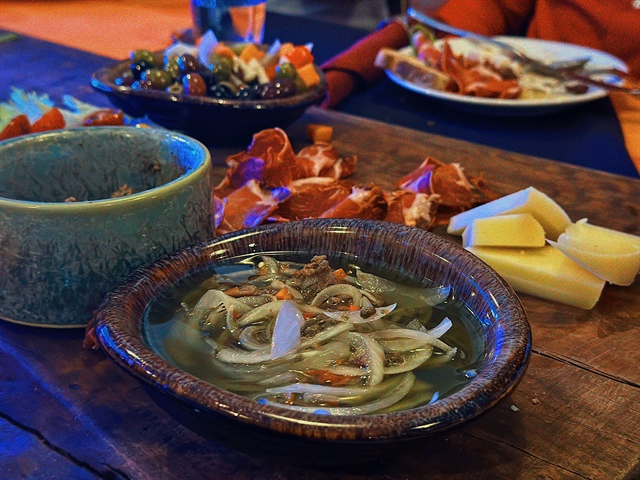 Restaurant Review
Restaurant Review

Thúy Hằng
Although the West Lake area is known for its endless array of great restaurants, I tend to stick to my usual spots. Most evenings out, I find myself choosing places either downtown or closer to home in Trung Hòa – a neighbourhood that earned the nickname "Korea Town" about a decade ago, thanks to its vibrant South Korean community and the wave of Korean eateries that followed.
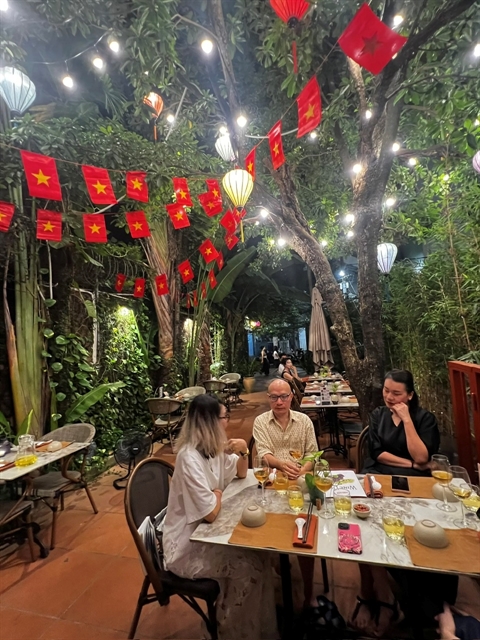 |
| A peaceful outdoor ambience comes from the leafy shade of old trees. VNS Photo Thúy Hằng |
Interestingly, the last two times I ventured out to Tây Hồ for dinner were both prompted by friends visiting from Hồ Chí Minh City. Coincidentally, both restaurants they picked were Vietnamese. For now, I’ll focus on the most recent outing.
My friend chose a place called "Chào Bạn", literally “Hello, Friend”. It proved a fitting name for a reunion of old friends who hadn’t seen each other in months.
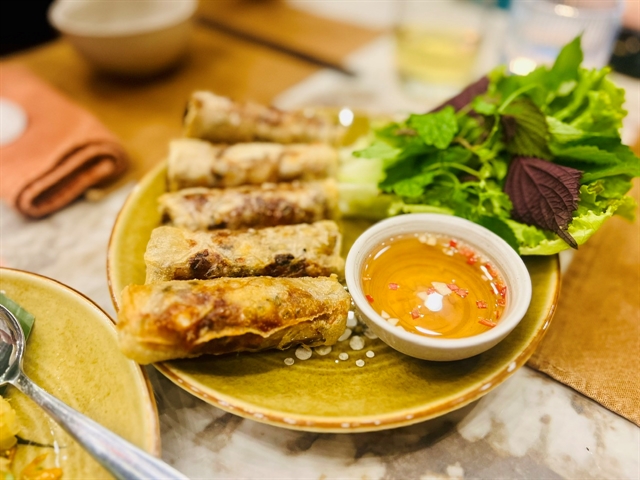 |
| Vincent’s deep-fried spring rolls might even surprise those who have made more spring rolls than they can remember. VNS Photo Thúy Hằng |
The restaurant is tucked away in a charming colonial-style villa, with tall windows and a staircase leading to a spacious dining room upstairs. It was one of those early autumn evenings – breezy and calm – so we opted for a table outdoors, right beside a small swimming pool and beneath the leafy shade of a towering sapodilla tree.
Our lively conversation never quite paused long enough for us to look at the menu, so we left the decision in the hands of the restaurant’s owner and head chef, Vincent Cao Minh Page – a man of both French and Vietnamese descent. Laughing, we joked that we were having an "omakase" dinner, Vietnamese style.
After a brief chat, Vincent disappeared into the kitchen and returned with two plates: fried spring rolls and pomelo salad.
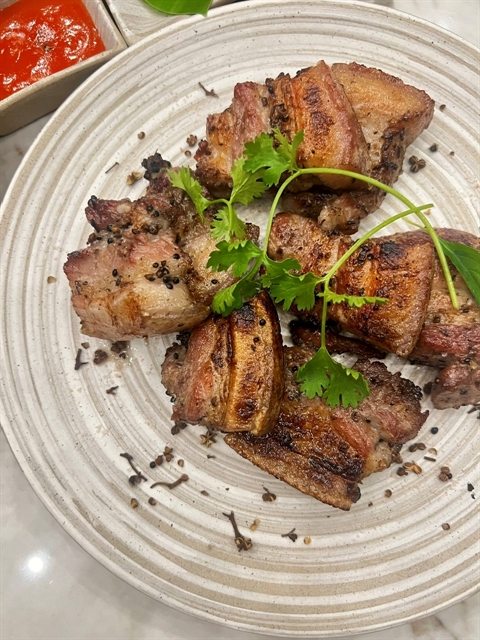 |
| Black pork seasoned with wild 'mắc khén' pepper. VNS Photo Thúy Hằng |
The spring rolls were unexpectedly exceptional – golden and crisp on the outside, with a hot filling that burst with the aroma of pepper and other fragrant ingredients. I felt a touch embarrassed to admit that Vincent’s version might actually surpass mine – and I’m a Vietnamese woman who’s made spring rolls more times than I can count.
The pomelo salad, however, didn’t leave quite the same impression. For this dish to truly shine, two elements are key: a perfectly ripe pomelo – lightly tart, subtly sweet, with firm, juicy segments – and a well-balanced dressing. Vincent’s salad had promise, but it would’ve been more complete with a richer, more flavourful sauce.
He has every reason to be confident. Born in Paris, Vincent grew up surrounded by the familiar flavours of Vietnamese dishes lovingly prepared by his mother. At just 16, he began apprenticing at a Vietnamese restaurant in Montmartre, where the owner – Bùi Đức Bình, originally from Hải Phòng – inspired him and taught him the fundamentals of hospitality.
His next mentor, Philippe Ricard, was a seasoned entrepreneur with a network of restaurants spanning Shanghai, Hong Kong, Taipei, and Hồ Chí Minh City.
In 2011, Vincent partnered with Ricard to open a French restaurant in HCM City, an experience that became a masterclass in building and sustaining a brand.
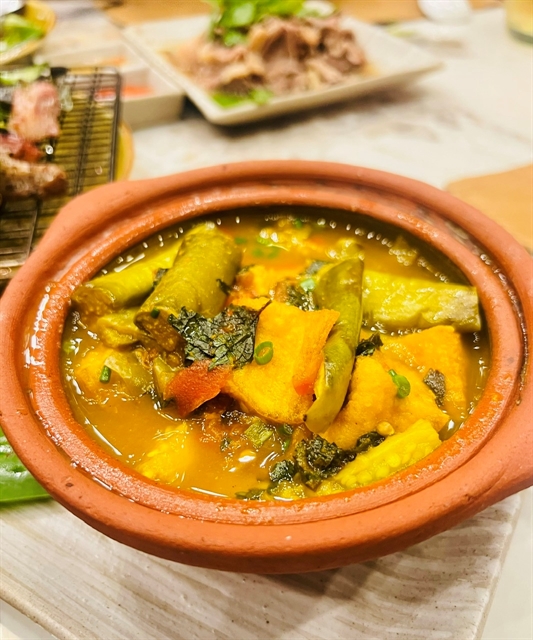 |
| Braised aubergine with tofu and green banana, served in a clay pot. VNS Photo Thúy Hằng |
Later, he trained under the acclaimed chef Didier Corlou, who ignited Vincent’s deep passion for Vietnamese cuisine. From Corlou, he learned how to infuse every dish with heart, and how to make that emotion resonate with each guest at the table.
After the appetisers, Vincent decided to up the protein game with two grilled specialties: black pork seasoned with wild mắc khén pepper, and pork infused with the fragrance of mác mật leaves. Both dishes were irresistibly flavourful, each bite layered with the bold, earthy aroma of natural spices. Paired with a glass of red wine, they reached a level of perfection hard to rival.
The protein parade continued with a stir-fried duck dish – one I’d never tried before. Like many beloved Vietnamese stir-fries, it featured minced garlic, but what truly elevated it was the pairing with Vietnamese basil. Vincent’s choice wasn’t just delicious; it was culturally spot-on. In Vietnamese cuisine, duck and basil are a classic duo, and his execution proved that his understanding of traditional flavours could rival that of any native chef.
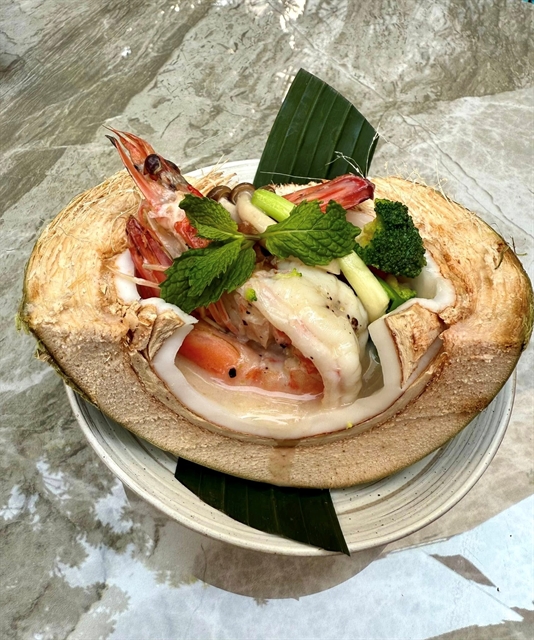 |
| Prawns in coconut cream. Photo courtesy of Chào Bạn |
Our "omakase" journey carried on with a humble yet deeply satisfying dish: braised aubergine with tofu and green banana, served in a clay pot. A staple of Northern Vietnamese home cooking, it’s a dish that relies on the harmony of simple ingredients. That harmony, however, is deceptively difficult to achieve.
Vincent nailed it. Each component – soft aubergine, creamy tofu and slightly tangy banana – melded into a comforting, flavourful whole. Once again, I had to admit: he made it better than I ever could.
We were fully immersed in the flow of Vietnamese flavours when Vincent introduced one final dish: prawns in coconut cream. Served in a fresh coconut, it featured tiger prawns and a medley of vegetables – mushrooms, carrots and broccoli – all gently simmered in naturally sweet coconut juice and enriched with a touch of coconut cream.
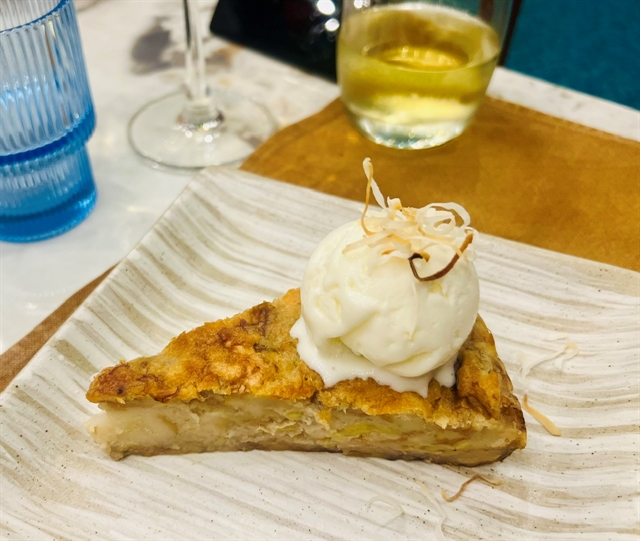 |
| Banana Cake by Madame Gigi |
It was a lovely dish – delicate and fragrant – though its flavour profile leaned slightly toward that of neighbouring Thai cuisine. While delicious, it felt like a brief detour from the distinctly Vietnamese journey we’d been savouring all evening.
Then came the grand finale "Banana Cake by Madame Gigi", a dessert originally made by Vincent’s mother back home. Warm and tender, the cake carried the gentle fragrance of ripe bananas and was beautifully paired with a scoop of coconut ice cream.
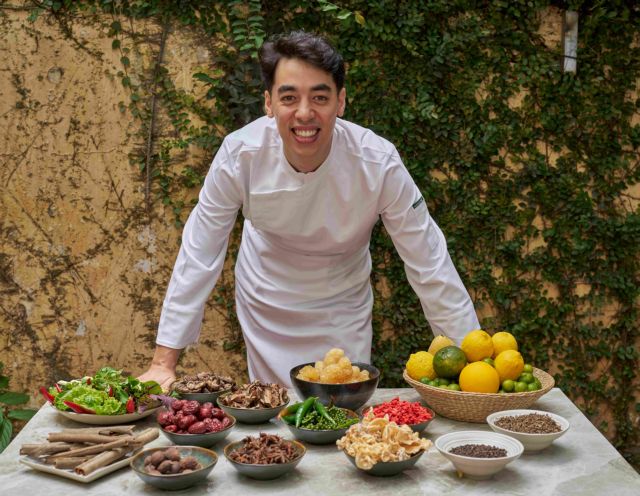 |
| Vincent Cao Minh Page, owner and head chef of Chào Bạn Restaurant. Photo courtesy of Chào Bạn |
Vincent shared that the banana cake was made using a cherished recipe passed down from his mother – a way for him to bring a slice of childhood memory into the Chào Bạn’s menu. Though Western in style, the dessert offered a refreshing departure that still felt in tune with the evening’s Vietnamese journey.
In addition to a menu featuring over 40 signature dishes from Việt Nam’s Northern, Central, and Southern regions, Chào Bạn also boasts an impressive wine list with more than 40 selections from renowned wine regions across France and Europe. According to Vincent, pairing French wine with Vietnamese cuisine is his way of showing that Vietnamese food can engage in a refined and captivating dialogue with any culinary tradition. VNS
----------
Chào Bạn
Address: Villa 28, Alley 11, Tô Ngọc Vân Street, Tây Hồ, Hà Nội
Tel: +84 (024) 35528028
Comment: A truly charming venue – peaceful and shady outdoors, with a cosy yet elegant interior. The deep-fried spring rolls and "Banana Cake by Madame Gigi" are absolute must-tries.




